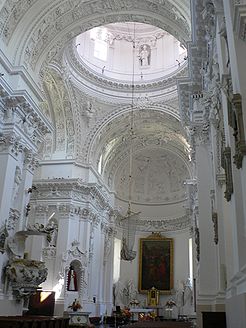- St. Peter and St. Paul's Church, Vilnius
-
St. Peter and St. Paul's Church
Šv. apaštalų Petro ir Povilo bažnyčia
Front view of the church
Basic information Location Vilnius, Lithuania Geographic coordinates 54.694°N, 25.306°E Affiliation Roman Catholic District Antakalnis Year consecrated 1701 Architectural description Architect(s) Jan Zaor, Giambattista Frediani Architectural type Church Architectural style Baroque Direction of façade Southwest Completed 1701 Specifications Materials clay bricks St. Peter and St. Paul's Church in Vilnius (Lithuanian: Šv. apaštalų Petro ir Povilo bažnyčia) is a Roman Catholic church located in the Antakalnis neighbourhood of the city. Its interior has masterful compositions of stucco mouldings by Giovanni Pietro Perti and ornamentation by Giovanni Maria Galli[1] of Milan, and is considered a Lithuanian Baroque masterpiece.
Contents
Architecture
The church is a basilica built on a traditional cross plan with a lantern dome allowing extra light into its white interior. The freestanding columns of the main facade were used for the first time in Lithuanian ecclesiastical architecture. The inscription surrounding the base of the dome (Tu es Petrus et supra hanc petram edificabo ecclesiam meam et portae inferi non praevale buntadversus eam) is the same as that of St. Peter's Basilica in the Vatican. The church is decorated with over 2000 religious depictions. The frescos are attributed to Johann Gotthard Berchhoff.[citation needed]. The female heads opposite the St. Augustine Chapel represent two sister nations: Poland and Lithuania.
History
It is believed that the first wooden church was built on this location after Jogaila's conversion. It was rebuilt at the end of 15th century, but was destroyed by a fire in 1594. Another wooden church was built between 1609-1616, but it also was destroyed during the wars with Russia in 1655-1661.
The construction of the new church was paid for by the Great Lithuanian Hetman Michał Kazimierz Pac in celebration of the victory against the Russians and the suppression of Lubomirski's Rokosz. The Latin inscription on the main façade REGINA PACIS FUNDA NOS IN PACE (Queen of Peace, protect us in peace) corresponds with the intention, as well as with the founder's name Pac. Pac demanded to be buried beneath the doorstep of the main entrance with the inscription "Hic Jacet Pecator" (Here Lies a Sinner) on his tombstone, which was parted by the lightning and was set in the wall, right of the main portal. A large Turkish war drum (timpano) is on display in the church. It was seized from the Ottomans in the Battle of Khotyn of 11 November 1673, won by the Commonwealth forces, and granted to the church by Michał Kazimierz Pac.
The construction works of the present church started in 1668 under the supervision of Jan Zaor from Kraków and finished in 1676 by Giambattista Frediani. The decoration works were unfortunately terminated in 1684 due to the founder's death in 1682, which prevented creating the main altar according to the original design. The decoration works were finally completed only in 1704.
The main altar, smaller than planned, was built in the beginning of 19th century by Giovanni Beretti and Nicolae Piano from Milan. It is dominated by the Farewell of St. Peter and St. Paul, a large drawing by Franciszek Smuglewicz, installed there in 1805.
See also
Image gallery
References
Categories:- Churches in Vilnius
- Buildings and structures completed in 1676
- Baroque architecture in Lithuania
Wikimedia Foundation. 2010.





